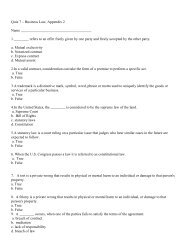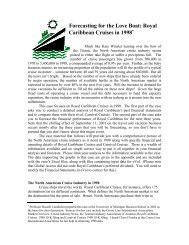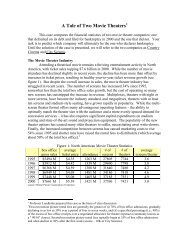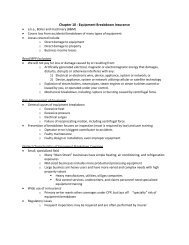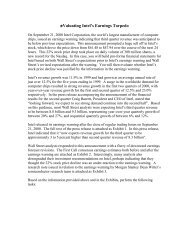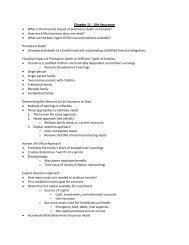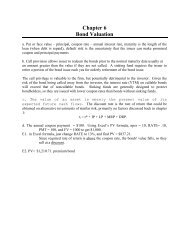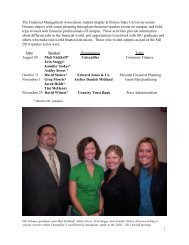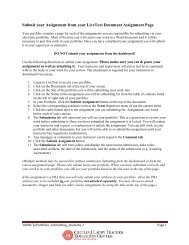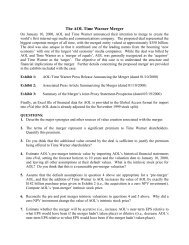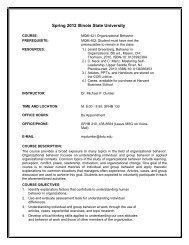Evaluating a Firm's External Environment - Illinois State University
Evaluating a Firm's External Environment - Illinois State University
Evaluating a Firm's External Environment - Illinois State University
Create successful ePaper yourself
Turn your PDF publications into a flip-book with our unique Google optimized e-Paper software.
M02_BARN4586_03_SE_C02.qxd 7/1/09 7:34 AM Page 49<br />
Chapter 2: <strong>Evaluating</strong> a Firm’s <strong>External</strong> <strong>Environment</strong> 49<br />
For some time now, scholars have<br />
been interested in the relative<br />
impact of the attributes of the industry<br />
within which a firm operates and the<br />
attributes of the firm itself on its performance.<br />
The first work in this area<br />
was published by Richard Schmalansee.<br />
Using a single year’s worth of data,<br />
Schmalansee estimated the variance in<br />
the performance of firms that was<br />
attributable to the industries within<br />
which firms operated versus other<br />
sources of performance variance.<br />
Schmalansee’s conclusion was that<br />
approximately 20 percent of the variance<br />
in firm performance was explained<br />
by the industry within which a firm<br />
operated—a conclusion consistent with<br />
the S-C-P model and its emphasis on<br />
industry as a primary determinant of a<br />
firm’s performance.<br />
Richard Rumelt identified some<br />
weaknesses in Schmalansee’s research.<br />
Most important of these was that<br />
Schmalansee had only one year’s<br />
worth of data with which to examine<br />
the effects of industry and firm attributes<br />
on firm performance. Rumelt was<br />
able to use four years’ worth of data,<br />
which allowed him to distinguish<br />
between stable and transient industry<br />
and firm effects on firm performance.<br />
Research Made Relevant<br />
The Impact of Industry and Firm<br />
Characteristics on Firm<br />
Performance<br />
Rumelt’s results were consistent with<br />
Schmalansee’s in one sense: Rumelt<br />
also found that about 16 percent of the<br />
variance in firm performance was due<br />
to industry effects, versus Schmalansee’s<br />
20 percent. However, only about half<br />
of this industry effect was stable. The<br />
rest represented year-to-year fluctuations<br />
in the business conditions in an<br />
industry. This result is broadly inconsistent<br />
with the S-C-P model.<br />
Rumelt also examined the impact<br />
of firm attributes on firm performance<br />
and found that over 80 percent of the<br />
variance in firm performance was due<br />
to these firm attributes, but that over<br />
half of this 80 percent (46.38 percent)<br />
was due to stable firm effects. The<br />
importance of stable firm differences in<br />
explaining differences in firm performance<br />
is also inconsistent with the S-C-P<br />
framework. These results are consistent<br />
with another model of firm performance<br />
called the Resource-Based View,<br />
which will be described in Chapter 3.<br />
Since Rumelt’s research, efforts<br />
to identify the factors that explain variance<br />
in firm performance have accelerated.<br />
At least nine articles addressing<br />
this issue have been published in the<br />
literature. One of the most recent of<br />
these suggests that, while the impact<br />
of the industry, the corporation, and<br />
the business on business unit performance<br />
can vary across industries and<br />
across corporations, overall, business<br />
unit effects are larger than either corporate<br />
or industry effects.<br />
Sources: R. P. Rumelt (1991). “How much does<br />
industry matter?” Strategic Management Journal,<br />
12, pp. 167–185; R. Schmalansee (1985). “Do markets<br />
differ much?” American Economic Review,<br />
75, pp. 341–351; V. F. Misangyi, H. Elms,<br />
T. Greckhamer, and J. A. Lepine (2006). “A new<br />
perspective on a fundamental debate: A multilevel<br />
approach to industry, corporate, and business<br />
unit effects.” Strategic Management Journal,<br />
27(6), pp. 571–590.<br />
competitors. However, DirecTV and television production companies are complementors<br />
to each other. In deciding whether to encourage the entry of new complementors,<br />
a firm has to weigh the extra value these new complementors will create<br />
against the competitive impact of this entry on a firm’s current complementors.<br />
It is also the case that a single firm can be both a competitor and a complementor<br />
to the same firm. This is very common in industries where it is important<br />
to create technological standards. Without standards for, say, the size of a CD, how<br />
information on a CD will be stored, how this information will be read, and so<br />
forth, consumers will often be unwilling to purchase a CD player. With standards<br />
in place, however, sales of a particular technology can soar. To develop technology<br />
standards, firms must be willing to cooperate. This cooperation means that, with<br />
respect to the technology standard, these firms are complementors. And indeed,



